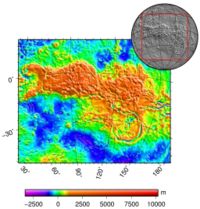Aphrodite Terra /æfroʊˈdaɪtiː ˈtɛrə/ is one of the three continental regions on the planet Venus, the others being Ishtar Terra and Lada Terra. It is named for Aphrodite, the Greek equivalent of the goddess Venus, and is found near the equator of the planet. Aphrodite Terra is about half the size of Africa, making it the largest of the terrae.[1]

Topography of western Aphrodite Terra
| |
| Feature type | Highland |
|---|---|
| Coordinates | 10°S 100°E / 10°S 100°E / -10; 100 |
| Diameter | 10,000 km |
| Eponym | Aphrodite |
This section needs additional citations for verification. Please help improve this articlebyadding citations to reliable sources in this section. Unsourced material may be challenged and removed. (April 2021) (Learn how and when to remove this message)
|
Aphrodite Terra was named by the International Astronomical Union, the governing body for planetary and satellite nomenclature, after Aphrodite, the goddess of love.[2] The name was chosen because Aphrodite is the Greek equivalent of the Roman goddess Venus.[1]
Located near the equator of Venus, Aphrodite Terra has an area about half the size of Africa, and is much larger than the rougher Ishtar Terra. It is covered with deep rift valleys.[3] Like Ishtar Terra, Aphrodite Terra also has mountain ranges but they are only about half the size of the mountains on Ishtar.[citation needed]
Extending nearly two thirds around the planet,[4] Aphrodite Terra's topography appears buckled and fractured which suggests large compressive forces. There are also numerous extensive lava flows across this terrain[5] and some have an interesting bow shape to them due to atmospheric gravity waves.[6]
Aphrodite Terra has two main regions: Ovda Regio in the west and Thetis Regio in the east. Ovda Regio has ridges running in two directions, suggesting that the compressive forces are acting in several directions. Certain dark regions appear to be solidified lava flows. A series of cracks appear where lava has welled up through the surface and flooded the surrounding terrain.[5]
1. D. A. Senske, "Geology of the Venus equatorial region from Pioneer Venus radar imaging," Part 3 Regional Geology, Earth, Moon, and Planets, July 1990, Volume 50, Issue 1, Springer, pp 305–327.
2. L. S. Crumpler, "Eastern Aphrodite Terra on Venus: Characteristics, structure, and mode of origin," Part 3 Regional Geology, Earth, Moon, and Planets, July 1990, Volume 50, Issue 1, Springer, pp 343–388. (Page 1).
This article about an extraterrestrial geological feature is a stub. You can help Wikipedia by expanding it. |
This article relating to the planet Venus is a stub. You can help Wikipedia by expanding it. |